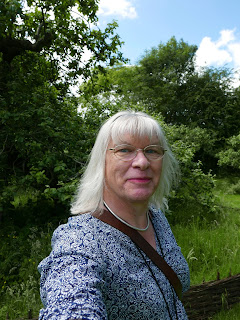Anyway, I went along, and the first thing I wanted to see, above all else, was the tree from which the apple fell - the one that gave young Isaac an insight into why things 'fell' downwards into the earth, and from that, to construct his theory of gravitational attraction. And they do still have that tree. It isn't quite as Isaac saw it. Most of the original growth has long gone, but the stump and roots remained, and from that a new tree has regenerated. It's certainly the same tree, and not a clone, so it's sort of authentic. Here it is, anyway:
It seemed de rigueur to pose in front of the tree, with a Newtonian gleam in one's eye!
The little orchard was opposite the front entrance of the manor house. It was a very pleasant spot. I can just imagine the young Isaac Newton, in frustrated mood, his head buzzing with slippery, half-grasped notions, flinging himself down in the welcome shade and hoping for inspiration. Meanwhile, no doubt, the family and the farmworkers looked furtively at him as if he were fey, or possessed by witchcraft.
The manor house was solidly-built but no palace. However, it offered all the basic comforts of a seventeenth-century squire's home.
I chatted extensively with both room guides and visitors. The Brexit Referendum and its possible consequences was still hot news. The room guides latched on to me, sensing my interest and liking my questions. My attention was drawn to many things not popularly associated with Isaac Newton, such as the country superstitions of the day. Here, for instance, lit up by a guide's torch, is a shape gouged with a knife in the plaster of the wall: a six-fingered hand. Done quite possibly by Isaac's parents, if not necessarily his personal work. It would be a sovereign defence against witches and evil spirits:
I suppose that in a world without electric light, illuminated only by hearths and candles - a world still obsessed with divine matters, with the Devil lurking in every dark corner, and those in league with him infesting the local community - it was natural and unremarkable to believe in witchcraft, and pay attention to anything that would bring good luck and protection against malignant forces. We still nail iron horseshoes to porches and doorways in much the same spirit. Isaac Newton would have known all about it, even if he sought to throw rationality and clear thinking at it all, perhaps wanting to 'explain magic' and its 'laws' in the same way he would explain gravity or the nature of light.
Upstairs, young Isaac had the luxury of his own bedroom.
The National Trust clearly thought him likely to be a very late riser, hogging a dishevelled bed. I'm trying to imagine his reaction if he woke to find all these visitors in his bedroom:
His Principia Mathematica (1687) was on display in both the original Latin and modern translations. I found it fascinating to see a style of presentation and a mathematical 'language' that seemed amazingly modern:
There was still the complex of farm buildings to look at. The barn had been made into a 'science centre', designed to get children thinking. All well beyond me, of course, but I enjoyed the Opticks section and its distorting mirrors. Great fun!
Lucy Longlegs!






















